Deadlifting 405 – Everything You Need to Know
Author:
Reviewed by:
(21 years of Oly Lifting experience)
Unlock your full potential by engaging with our experts and community! Have questions about your fitness journey or looking for expert advice on weightlifting techniques? Don’t hesitate — leave a comment below and Sergii Putsov will provide a personalized answer and insights to help you reach your goals.
Torokhtiy is reader-supported. Some links are affiliate links, and we may earn a commission at no extra cost to you. See our disclosure page for details.
Deadlifting provides an excellent measure of your overall strength and power. It requires your upper and lower body to work together to generate enough power off the floor whilst keeping your body in an optimal lifting position.
Deadlifting 405, also known as lifting four 45 pound plates, is a common aim in the lifting community. So, how easy is it to lift? What factors affect your deadlift strength? I’ve discussed this below to help you lift more off the floor.
Deadlifting 405 will take at least a year to achieve with a well-organized, periodized training program. A 405 deadlift takes more time for most lifters, with different factors affecting progress.
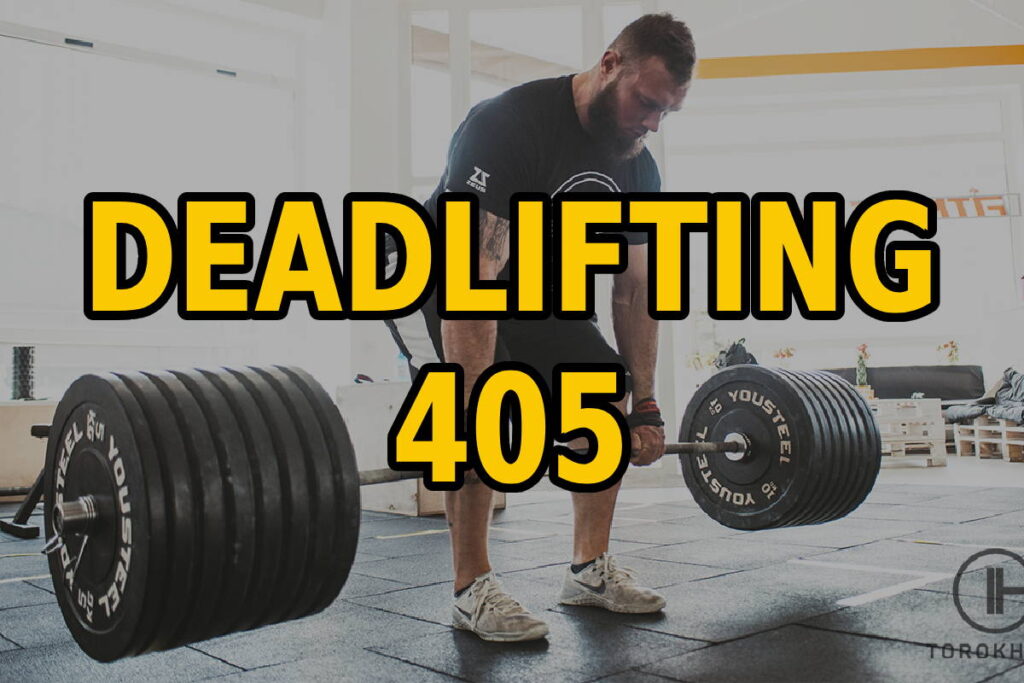
What Do The Strength Standards Mean?
Strength standards are an arbitrary level of strength that you can expect to achieve for different lifts. They are most commonly used for the deadlift, squat, and bench which are known as the big three lifts in the powerlifting community.
Different factors such as age and gender can affect your strength level. I’ll go into more detail regarding these later in the article. For now, let’s focus on what the strength standards mean:
Beginner – A beginner lifter can perform a deadlift with the correct technique. They have practiced for at least a month. Stronger than 5% of lifters.
Novice – A novice lifter has been training for at least six months with success. They can perform the correct deadlift technique whilst progressing their deadlift number. Stronger than 20% of lifters.
Intermediate – An intermediate lifter has been training the deadlift regularly for at least two years. Their numbers have been steadily progressing and they incorporate some accessory work and deadlift variations. Stronger than 50% of lifters.
Advanced – An advanced lifter has seen deadlift progression over a period of five years. They perform periodized deadlift-specific training, with multiple variations and accessory work programmed successfully. Stronger than 80% of lifters.
Elite – An elite lifter has dedicated over five years to serious training. They regularly compete at an elite level. Stronger than 95% of lifters.
Here are the deadlift standards according to the lifter categories I’ve described above:
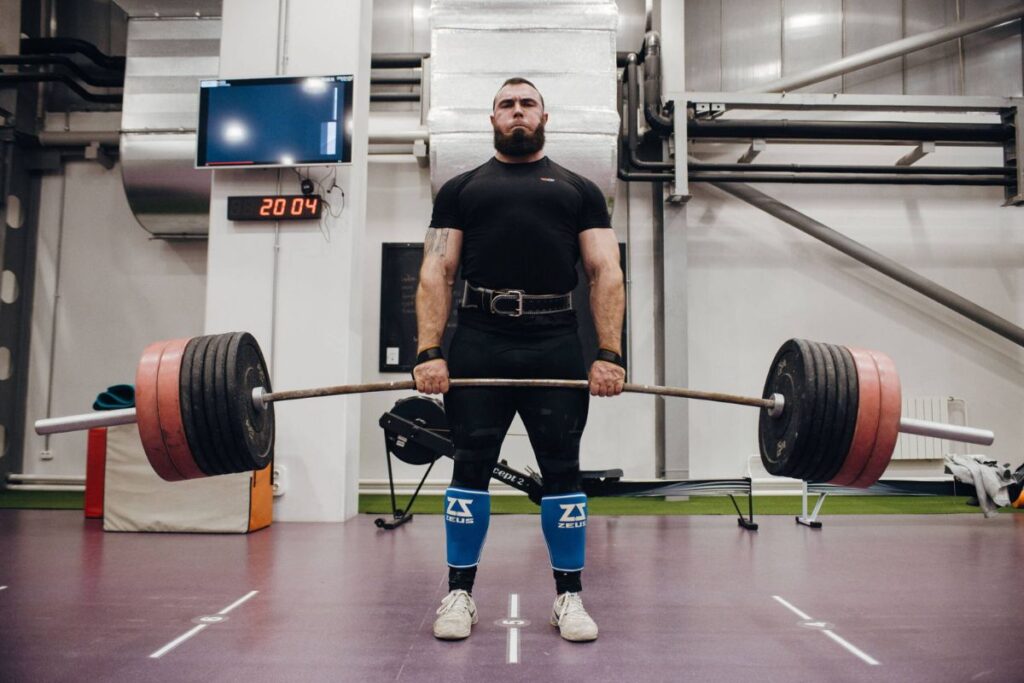
1. Male Deadlift Standards (Lbs)
| Strength Level | Deadlift Weight (lbs) |
|---|---|
| Beginner | 173 lbs |
| Novice | 246 lbs |
| Intermediate | 336 lbs |
| Advanced | 440 lbs |
| Elite | 552 lbs |
2. Female Deadlift Standards (Lbs)
| Strength Level | Deadlift Weight (lbs) |
|---|---|
| Beginner | 84 lbs |
| Novice | 132 lbs |
| Intermediate | 193 lbs |
| Advanced | 265 lbs |
| Elite | 345 lbs |
Is 405 A Good Deadlift?
Whatever your ability level, a 405-pound deadlift (four 45 pound plates) is an excellent amount of weight to lift off the floor. It takes months to years of dedicated training where you need to generate enough power off the ground using the correct technique to lift it successfully.
In any commercial gym, a 405 deadlift would be classed as an impressive lift among the recreational lifting community. Specialized powerlifting gyms would be different, but these aren’t your average lifters.
If you’re a make under 220 pounds, a 405 deadlift would be classed as an advanced to elite level lift. If you’re a woman, a 405 deadlift would be beyond elite level whatever your body weight is.
Follow us!

Free!
Get a 2-week Weightlifting Program as a bonus for the subscription to kickstart your training plan!

Free!
What Affects The Weight For Deadlifting?
When working towards 405 pounds, you need to take different factors into account. I’ve summarised some of them below.
1. Bodyweight
As you get heavier, the amount of weight you can lift off the floor gets easier. This is why competitive lifts are measured by taking body weight into account rather than raw numbers.
For example, for a 130-pound male, a 405-pound deadlift would be elite as its 3x bodyweight. The same lift for a 300 male would be 1.5x bodyweight and only classed as a novice lift.
Here are the expected strength standards at different body weights for men and women.
Male Strength Standards (Bodyweight)
| Bodyweight (lbs) | Strength Standards (lbs) (Novice – Elite) |
|---|---|
| 110 | 96-352 |
| 120 | 111-380 |
| 130 | 126-407 |
| 140 | 140-433 |
| 150 | 154-457 |
| 160 | 168-481 |
| 170 | 181-503 |
| 180 | 195-525 |
| 190 | 208-546 |
| 200 | 220-567 |
| 210 | 233-587 |
| 220 | 245-606 |
| 230 | 257-624 |
| 240 | 268-642 |
| 250 | 280-660 |
Female Strength Standards (Bodyweight)
| Bodyweight (lbs) | Strength Standards (Novice – Elite) |
|---|---|
| 110 | 54-264 |
| 120 | 61-279 |
| 130 | 80-319 |
| 140 | 86-331 |
| 150 | 92-343 |
| 160 | 97-353 |
| 170 | 103-363 |
| 180 | 108-373 |
| 190 | 113-382 |
| 200 | 118-391 |
| 210 | 123-400 |
| 220 | 127-325 |
| 230 | 132-416 |
| 240 | 136-424 |
| 250 | 140-431 |
The exact reason for the disparity in lifting numbers with weight differences isn’t clear, but these are some of the contributing factors:
- More muscle mass
- More connective tissue around the joints to provide lifting stability
- Better body leverage and a stronger lifting base
2. Gender
Strength standards are much higher for men than for women at the same body weight levels as you can see from the tables above.
Simply put, men are stronger than women. This mainly comes down to differences in muscle size, with muscle tissue composition similar between genders.
3. Programming
If you’re looking to increase your deadlift numbers, a well-made program matters. If you’re training specifically for the deadlift, you’ll likely see much faster increases compared to someone who is doing a more general strength program.
A periodized deadlift program should be designed so that different training variables are manipulated to maximize your training adaptations. Factors that can be changed include intensity, volume, and training frequency.
For example, your deadlift training may involve different variations, accessory exercises, and lifting volumes in each session.
Programming can have a huge effect on your deadlifting number, with an approach using a combination of scientific principles and your preferences usually the best.
4. Experience Level
If you’re someone with a lot of previous lifting experience, you’ll most likely find it much easier to rebuild lost strength compared to someone who is starting from the beginning.
This is generally due to a combination of muscle memory and technique cues that become familiar to you once you start lifting again.
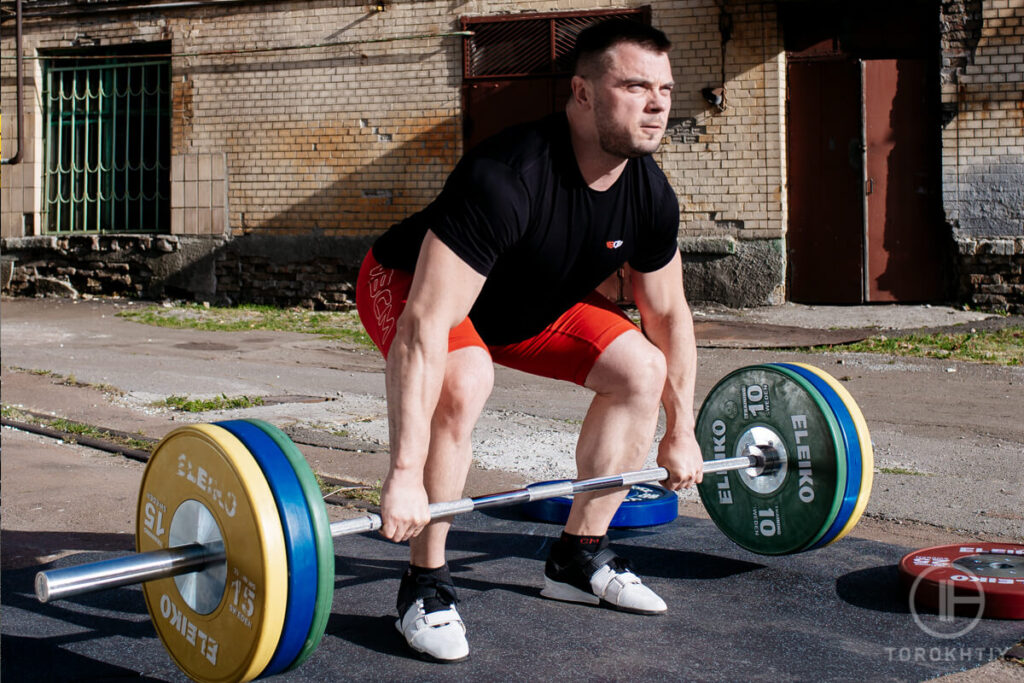
Muscle memory allows us to recover lost muscle much quicker compared to someone who has never had the muscle to begin with. Movement patterns are easier to re-learn, with proprioception allowing us to recruit the same muscle groups as we used in our previous training history.
5. Genetics
Even if you account for all the other factors above, you can’t change the genetics you’re born with. Some people just respond to training much better than others, with factors such as hormone levels and biomechanics playing a key role.
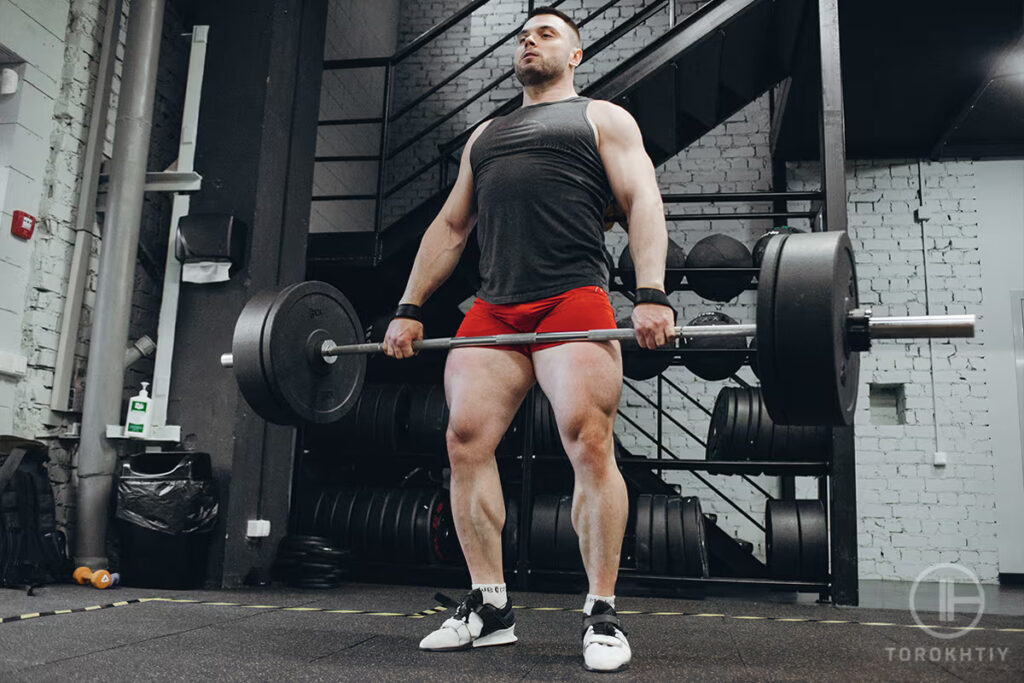
How To Deadlift 405 Lbs
Here are some great tips to improve your deadlift and get to 405 pounds:
1. Practice Your Technique:
- Assume the correct stance before placing your hands on the bar. Check your feet are correctly positioned in relation to your body and the bar
- Drive through the floor as you lift the bar off the ground. Think about driving through your heels
- Keep a neutral spine position with your head facing forward
- Take the slack out of the bar and contract your lats before lifting
2. Perform Accessory Work
- Address your weak points at different phases in the lift by doing regular accessory work
- Perform the exercises after your main compound lifting session is finished
- Divide your deadlift into the bottom pull, mid-range, and lockout
- Use popular accessory exercises such as deficit deadlifts, banded deadlifts, and rack pulls depending on your weak point
3. Build Muscle Strength
- Improve the strength of your prime movers including your quads, hamstrings, glutes, and back
- Add exercises such as leg presses, hip thrusts, and good mornings into your workout routine
FAQ
Can Women Deadlift 405 Pounds?
Strength standards are higher for men due to differences in biology and genetics.
Deadlifting 405 as a woman would be considered an elite lift even for heavier lifters.
It’s definitely possible, but would require years of training to achieve.
How Long Will It Take To Deadlift 405 Or 500 Pounds?
Deadlifting 405 pounds will take at least one year of well-organized training, with most people taking longer. Getting to 500 pounds will take years of serious training, with most people never achieving it.
Deadlifting 500 pounds is classed as an elite lift, with a specific deadlift strength program required.
Conclusion
A 405 pound deadlift is achievable for most recreational gym goers with a well-organized gym program. Some lifters may take around a year whilst others will take much longer. Women lifting 405 are classed as elite-level lifters meaning it takes much longer than men to achieve.
Factors such as age, gender, training history, and genetics may all play a role. Practice the correct technique, perform regular accessory work, and strengthen your prime movers to improve your deadlift performance.
Have you deadlifted 405 before? What are your current deadlift goals? Talk to me down below!
Also read:
- Deadlift Bar vs Stiff Bar
- Do Deadlifts Work Abs
- How to Keep Back Straight Deadlift
- Deadlift Everyday
- Deadlift on Back or Leg Day
- How to Hook Grip Deadlift
- Bad Deadlift Form
References:
- The Relationship Between Physical Characteristics and Maximal Strength in Men Practicing the Back Squat, the Bench Press and the Deadlift // NCBI: https://www.ncbi.nlm.nih.gov/pmc/articles/PMC7039481/
- A Comparison between Male and Female Athletes in Relative Strength and Power Performances // NCBI: https://www.ncbi.nlm.nih.gov/pmc/articles/PMC7930971/
- Current Concepts in Periodization of Strength and Conditioning for the Sports Physical Therapist // NCBI: https://www.ncbi.nlm.nih.gov/pmc/articles/PMC4637911/
- The concept of skeletal muscle memory // Wiley: https://onlinelibrary.wiley.com/doi/full/10.1111/apha.13465
- Genetics and Athletic Performance // OpenAccess: http://openaccess.lokmanhekim.edu.tr/bitstream/handle/20.500.12591/437/Essay%20I.pdf
Why Trust Us?
With over 20 years in Olympic weightlifting, strength training, nutrition coaching, and general fitness our team does its best to provide the audience with ultimate support and meet the needs and requirements of advanced athletes and professional lifters, as well as people who strive to open new opportunities and develop their physical capabilities with us.
By trusting the recommendations of our certified experts in coaching, nutrition, and sports training programming, as well as scientific consultants, and physiotherapists, we provide you with thorough, well-considered, and scientifically proven content. All the information given in the articles concerning workout programming, separate exercises, and athletic performance, in general, is based on verified data.
The product testing process is described in more detail here.
Author: Sergii Putsov
Head of Sport Science, PhD
Best Results: Snatch – 165 kg,
C&J – 200 kg
Sergii Putsov, Ph.D., is a former professional weightlifter and National team member, achieving multiple medals in the 94 kg weight category at national competitions. With a Master’s degree in “Olympic & Professional Sport Training” and a Sport Science Ph.D. from the International Olympic Academy, Greece, Sergii now leads as the Head of Sport Science. He specializes in designing training programs, writing insightful blog articles, providing live commentary at international weightlifting events, and conducting educational seminars worldwide alongside Olympic weightlifting expert Oleksiy Torokhtiy.
Reviewed by: Oleksiy Torokhtiy
Olympic Weightlifting Champion, PhD in Sport Science
Best Results: Snatch – 200 kg,
C&J – 240 kg
Oleksiy Torokhtiy is a professional athlete boasting 20 years of experience in Olympic weightlifting. With multiple European and World titles under his belt, he has showcased his prowess in two Olympic Games (Beijing 2008 and London 2012). Upon concluding his illustrious career, Oleksiy dedicated himself to coaching. By 2022, he had conducted over 200 weightlifting seminars worldwide. He is the visionary behind an international sportswear and accessories brand known for its motto, “Warm Body Cold Mind.” Additionally, he is an esteemed author and the creator of a series of training programs and eBooks.




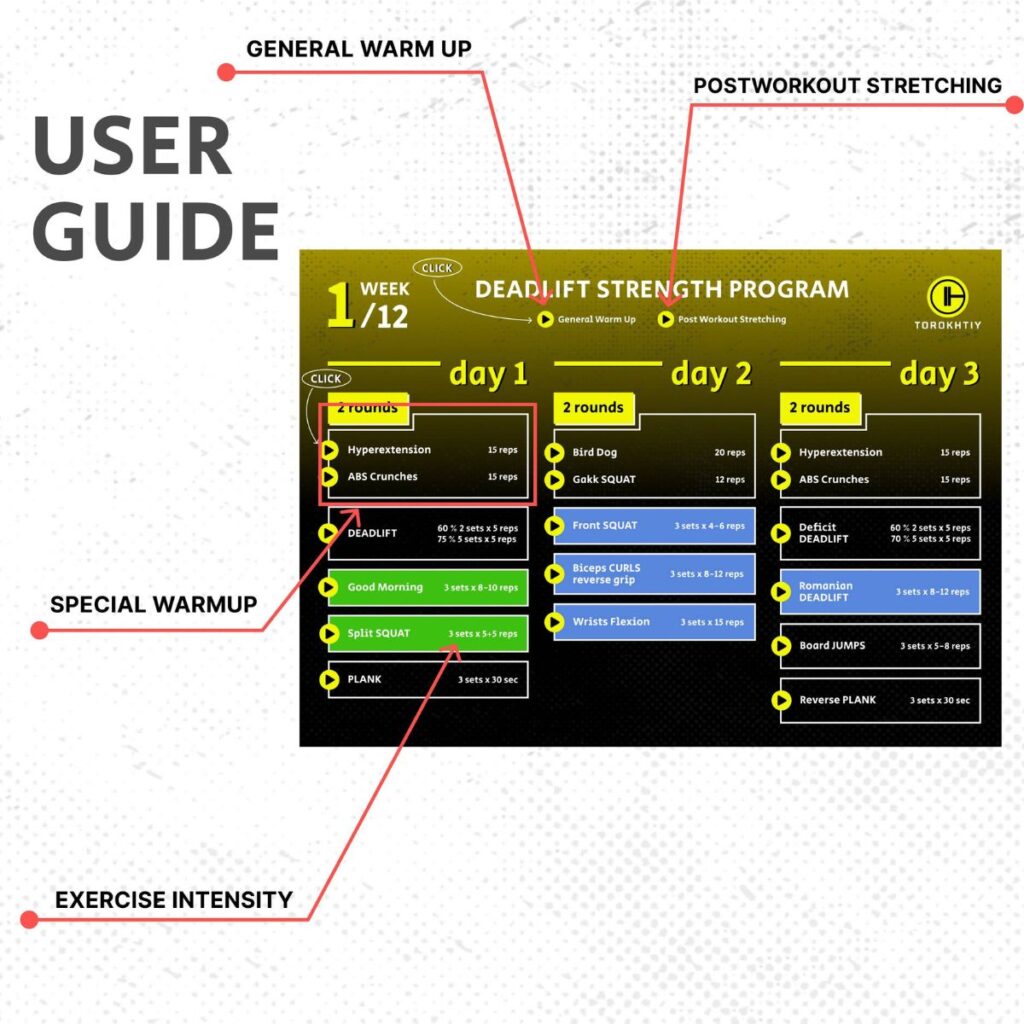
Still have questions after reading our article? Unlock your full potential by engaging with our experts and community! Don’t hesitate — leave a comment below and Sergii Putsov will provide a personalized answer and insights to help you reach your goals.